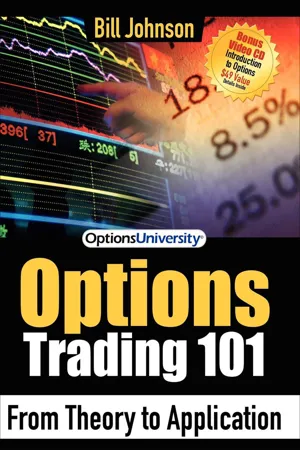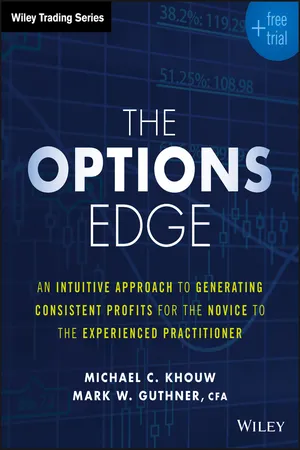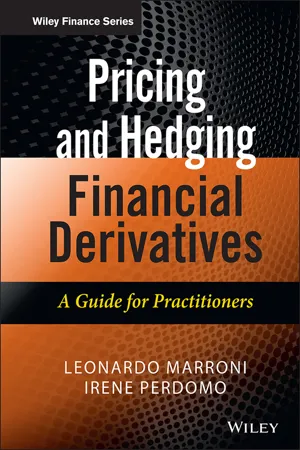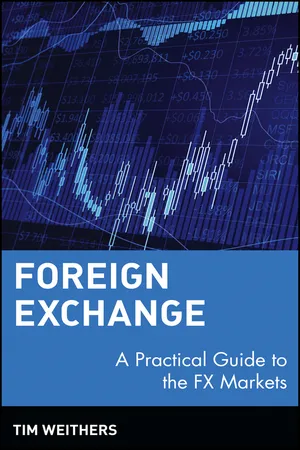Business
Put Call Parity
Put-call parity is a principle in options pricing that establishes the relationship between the prices of call and put options with the same strike price and expiration date. It states that the difference between the call and put option prices should be equal to the difference between the current stock price and the present value of the strike price. This concept helps in understanding and valuing options.
Written by Perlego with AI-assistance
Related key terms
Related key terms
1 of 4
Related key terms
1 of 3
6 Key excerpts on "Put Call Parity"
- eBook - ePub
Options Trading 101
From Theory to Application
- Bill Johnson(Author)
- 2007(Publication Date)
- Morgan James Publishing(Publisher)
Chapter Five Put-Call Parity and Synthetic Options Up to this point, calls and puts appear to be polar opposites. Calls represent the right to buy while puts represent the right to sell. And if you look at option quotes, there doesn’t appear to be any connection between the price of the call and the same-strike put. However, call and put prices are highly dependent and are not arbitrarily chosen. Although it may not appear possible, there is a strong, mathematical relationship that describes the connection between calls and puts known as put-call parity. This is one of the most important concepts for beginning and advanced option traders alike, so we will devote an entire chapter to it. Once you understand put-call parity, you’ll find that calls and puts are really one in the same; it just depends on how they’re paired with the underlying stock. So, strange as it may sound, calls are really puts and puts are really calls if properly paired with the underlying stock. In fact, when options were first introduced in 1973, only call options were traded on 16 stocks. Put options did not appear until 1977. The reason is that puts were created by “put-call brokers” who created puts by properly pairing calls with the underlying stock and put-call parity show them how to do just that. The word “parity” means “equivalence.” There are many types of parity relationships in the financial world such as purchasing power parity and interest rate parity, for example. Parity relationships simply show the connections between two or more variables. As stated before, put-call parity just shows that calls and puts are “equivalent” when properly paired with the underlying stock. Once you understand put-call parity, you will have increased insights into the mechanics of the options market and how options are priced - eBook - ePub
The Options Edge
An Intuitive Approach to Generating Consistent Profits for the Novice to the Experienced Practitioner
- Michael C. Khouw, Mark W. Guthner(Authors)
- 2016(Publication Date)
- Wiley(Publisher)
Put–call parity defines the relationship between the prices of a European call, a European put, the underlying security, and the risk-free asset. For this relationship to hold, the strike price and the time to expiration of the put and the call must be identical. In addition, the risk-free asset that is typically defined as a U.S. Treasury bill must have the same maturity date as the expiration date of the two options. In the case of equity securities, the equation for put–call parity is defined below. Put–call parity does not just apply to stocks and their related options. It governs the relationship between the price of any asset and its associated options.The intuition behind this equation should be very clear. The left-hand side of the equation describes a stock with a married put having the same payoff pattern as holding cash plus a call option. Given this identity, if the price of the stock rises by the expiration date of the put, the investor can sell the stock for a gain while the put expires worthless. If the price of the stock falls below the strike price of the put option, the investor can exercise her right and sell the stock to the put writer at the agreed upon strike price. This will minimize investor loss, which is equal to the starting stock price less the option's strike price less the premium paid on the put option.The right-hand side of the equation is another way of describing the same payoff pattern. Instead of buying stock and a married put, the investor buys a call option, keeping the rest of her assets in credit and interest rate risk-free cash equivalents. If the price of the underlying stock is above the strike price by expiration, the investor exercises the call and sells the stock purchased for a gain. If, on the other hand, the price of the stock falls, the call expires worthless, leaving the investor with cash. All that is lost in this scenario is the option premium on the call.The beauty of put–call parity lies in its simplicity, requirement for minimal assumptions, and ease of implementation. Put–call parity allows for the static replication of any of its four elements. In addition, with the assumption that traders can freely borrow and lend at the same rate, cash on hand is not necessary to structure a trade. In theory, borrowing funds for the term of the options can finance the underlying asset and the relationships still holds. Furthermore, it does not require the existence of a forward contract, although one can be created synthetically. In addition, put–call parity presents the relationship of static replication. In a static replication, the reference asset and the replicating portfolio have the same cash flows. By contrast, dynamic replication does not have the same cash flows as the reference asset. A good example of dynamic replicating is gamma scalping. The payoff pattern of a call option is created dynamically by purchasing the underlying asset as its price rises and selling it as its price falls. The end result is a payoff pattern that looks identical to the final payoff pattern of a call option, but the cash flows are different. - eBook - ePub
Commodities and Commodity Derivatives
Modeling and Pricing for Agriculturals, Metals and Energy
- Helyette Geman(Author)
- 2009(Publication Date)
- Wiley(Publisher)
T]. Whenever it is feasible just to use such arguments in order to prove a result, it is clear that we should do so; unfortunately, this situation will be rare. Traders do try to identify such situations in practice; in their language, the put-call parity states that a portfolio consisting of a stock and a European put can be statically replicated by a call and a position in money market account M. This money market account is the riskless asset in the situation of constant interest rates and grows at the continuously compounded rate r.Note also that at date T a portfolio P’ comprising the stock - or commodity - and a put written on it has a final value equal to the sum of the components’ market prices at date T :(4:2)If the stock or commodity market goes up between dates t and T , S(T) is very high; the maximum of the two quantities will be S(T) and the investor will have benefited from the rise in prices. Conversely, if markets crash, S(T) is very low and the maximum is equal to k.Hence, instead of collapsing to zero as it would have if the portfolio P’ had contained only S, the investor’s wealth is equal to k. This simple but fundamental use of put options is called portfolio insurance, the put providing protection against downward movements.Formula (4.2) satisfies the first two fundamental motivations of any investor:1. Benefiting from a market rise if it occurs, which may also be expressed by a wealth utility with a strictly positive derivative.2. Limiting the investor’s losses to a minimal wealth of k dollars in the case of market decline. This floor satisfies investor risk aversion, a feature that has been exhibited in experiments conducted for a long time by sociologists and economists; risk aversion is expressed by a concave utility function (i.e., a negative second derivative). - eBook - ePub
Your Options Handbook
The Practical Reference and Strategy Guide to Trading Options
- Jared Levy(Author)
- 2011(Publication Date)
- Wiley(Publisher)
In the synthetics section, you learned how we can create a synthetic long or short stock position using options. Usually there are only minor differences in the cost of creating a synthetic versus just going out and buying the stock (other than commissions, of course). The reason for this is put-call parity, which is the natural three-sided relationship between a call and put and the underlying instrument (stock, etc.).Here are the three characteristics that are referred to as put-call parity:1. Underlying price = call price – put price + exercise price.2. Put price = call price – underlying price + exercise price.3. Call price = underlying price + put price – exercise price.Trader TipCheck out some options chains after the market closes and see if you can prove put-call parity. Just be sure that your stock is not hard to borrow—that will make the put more expensive and thus put-call parity may cease to exist.If the time value for the put is different from the call, there will be a difference in the synthetic position compared to a real stock position, making the synthetic either too cheap or too expensive.By the way, if these concepts make absolutely no sense to you, don’t worry; understanding put-call parity and synthetics in gross detail is not a prerequisite to making money with options. Furthermore, in today’s extremely efficient markets, this knowledge will have minimal benefit to you as a retail trader.Using Options to Lend or Borrow MoneyOptions can be used to borrow and lend money; for example, what if you bought a nondividend-paying stock at a specific price from a person who needed to borrow money from you (there is the initial loan collateral)? Then you synthetically created a short stock position using a short call and long put that expire two years in the and make the borrower take the other side of the trade, meaning she has to buy a call and sell a put, and for a fee, which you set (your interest payment). In this example, you have essentially created a direction-neutral (100% hedged) position in that stock. - eBook - ePub
Pricing and Hedging Financial Derivatives
A Guide for Practitioners
- Leonardo Marroni, Irene Perdomo(Authors)
- 2014(Publication Date)
- Wiley(Publisher)
T ) = 1. As above, the lower boundary for the put option is equal to:Now, assume that the option price available in the market is 5, i.e., it is lower than its lower bound value of 10. Market participants could buy this option for 5 and buy the underlying at 90. The profit and loss in this case is:- Profit and loss on the long position in the option = option payoff – premium paid for the option = Max(100 – ST, 0) – 5.
- Profit and loss on the long position in the underlying = final price of the underlying – purchase price of the underlying = ST– 90.
IfST≥ 100, i.e., the put expires worthless, the profit and loss is:On the other hand, ifAs in the case of call options, and irrespective of the future dynamic of the underlying price, there is a straightforward strategy that allows one to lock in a profit of at least 5. 3.4 PUT–CALL PARITYST< 100, i.e., the put expires in-the-money:So far we have looked at the upper and lower bound for individual puts and calls. We will now introduce a very important relationship between call and put options, known as the put–call parity . The put–call parity allows us to express the price of a put relative to the price of the call and vice versa.The intuition behind the put–call parity stems from the fact that it is possible to combine a long position in a call option and a short position in a put option with the same strike and expiry (and, obviously, the same underlying asset) to replicate a long position in the underlying asset itself. Symmetrically, it is possible to combine a short position in a call option and a long position in a put option with the same strike and expiry (and, obviously, the same underlying asset) to replicate a short position in the underlying asset itself. - eBook - ePub
Foreign Exchange
A Practical Guide to the FX Markets
- Tim Weithers(Author)
- 2011(Publication Date)
- Wiley(Publisher)
on foreign exchange. Why?Returning to our earlier put-call parity thought experiment above, we started by asking what must be true if we bought a share of stock and then effectively sold that share through the simultaneous purchase of a European put and sale of a European call with the same strike price. More specifically, something has to be changed here with foreign exchange. With stock, we bought one share and traded two options each covering one share; in foreign exchange, this would be wrong. Why? Foreign exchange is money and money “grows.” Consider USD|CHF: If we buy a put on one Dollar and sell a call on one Dollar, our earlier inclination would lead us to want to buy one Dollar (to deliver against whichever of these two options ended up in the money at expiration), but if we did buy one Dollar, and we put that Dollar into an account that generated interest, we would have purchased more USD than we needed. Although it may sound odd, all we need to purchase today is “the present value of a Dollar” (some amount less than one Dollar, which will grow into one Dollar by expiration (for delivery versus the options).Being more explicit, and staying with USD|CHF, then the “no-arbitrage” condition would be based onCash Flow Today:Sell a call + C (a call on USD 1 quoted in CHF) Buy a put – P (a put on USD 1 quoted in CHF) Buy the present Value of USD 1 (in CHF) This involves buying not USD 1, but USD .9524, which is1/(1 + rUS t) = 1/1.05 = .9524Cash Flow at ExpirationSell USD 1 for + X (which is quoted in CHF)So, put-call parity in FX could be written (for our USD|CHF example and in general):where, in both forms, the discounting or present valuing is done using the interest rate associated with the currency units that are being quoted. For example, with USD|CHF, since S, X, C, and P are all quoted in terms of CHF, it is the CHF rate that is used to present value. There is an obvious similarity between equation (9.8) and equation (9.12) . Furthermore, there are similarities between the continuous version of equation (9.11)Simple Interest Continuous InterestFor USD|CHF:(9.9)In general:(9.10)Rearranging into the form of put-call parity (C = P +/ – . . . ):(9.11) And, if we substitute—converting our S into the corresponding F: then,(9.12)
Index pages curate the most relevant extracts from our library of academic textbooks. They’ve been created using an in-house natural language model (NLM), each adding context and meaning to key research topics.
Explore more topic indexes
Explore more topic indexes
1 of 6
Explore more topic indexes
1 of 4





